Calstock
Calstock (Cornish: Kalstok[2]) is a civil parish and a large village in south east Cornwall, England, United Kingdom, on the border with Devon. The village is situated on the River Tamar 6 miles (9.7 km) south west of Tavistock and 10 miles (16 km) north of Plymouth.[3]
Calstock
| |
|---|---|
| Village & Parish | |
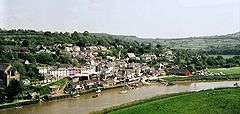 Calstock village from the viaduct | |
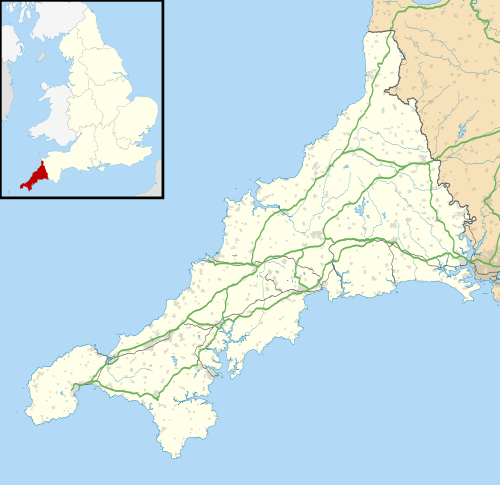 Calstock Location within Cornwall | |
| Area | 23.79 km2 (9.19 sq mi) |
| Population | 6,253 2011 Census including Albaston , Dimson and Latchley[1] |
| • Density | 263/km2 (680/sq mi) |
| OS grid reference | SX4368 |
| • London | 191 Miles |
| Civil parish |
|
| Unitary authority | |
| Ceremonial county |
|
| Region | |
| Country | England |
| Sovereign state | United Kingdom |
| Post town | CALSTOCK |
| Postcode district | PL18 |
| Dialling code | 01822 |
| Police | Devon and Cornwall |
| Fire | Cornwall |
| Ambulance | South Western |
| UK Parliament | |
| Website | Calstock |
The parish had a population of 6,095 in the 2001 census.[4] This had increased to 6,431 at the 2011 census.[5] The parish encompasses 5,760 acres (23.3 km2) of land, 70 acres (0.28 km2) of water, and 44 acres (0.18 km2) of the tidal Tamar.[6]
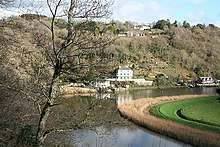
As well as Calstock, other settlements in the parish include Albaston, Chilsworthy, Gunnislake, Harrowbarrow, Latchley, Metherell, Coxpark, Dimson, Drakewalls, Norris Green, Rising Sun and St Ann's Chapel.[7]
Calstock village is within the Tamar Valley AONB, is overlooked by Cotehele house and gardens, and lies on the scenic Tamar Valley railway. Calstock railway station opened on 2 March 1908. The village is twinned with Saint-Thuriau in Brittany, France.
Early history

There is evidence of human settlement in Calstock from Roman, or pre-Roman times, settlers attracted by the rich source of minerals, such as tin, in the area. An iron age hill fort is to be found in the north of the parish. A Roman fort, only the third known in Cornwall, was discovered next to the church in 2008.[8] It is thought that up to 500 soldiers would have been based here. More recent excavations have revealed the presence of a Roman mine consisting of pits connected by a network of tunnels. There is also evidence of a Roman road in the vicinity.[9]
In Saxon times Calstock was in the Kingdom of Cornwall, which resisted the spread of Wessex from the east. In 838 CE Wessex had spread as far as the Tamar, and a battle for independence was fought near Calstock. Following the Norman Conquest, Calstock manor was recorded in the Domesday Book, referred to as Callestock. The Saxon manor (held by Asgar) was taken over, and in the 14th century became part of the Duchy of Cornwall: one of the 17 Antiqua maneria. At the time of Domesday Book (1086) the manor was held by Reginald from Robert, Count of Mortain. There were two and a half hides of land and land for 12 ploughs. Reginald held one virgate of land with 2 ploughs and 12 serfs. 30 villeins and 30 smallholders had the rest of the land with 6 ploughs. There were 100 acres of woodland, 3 square leagues of pasture and 3 pigs. The value of the manor was £3 sterling though it had formerly been worth £6.[10] The manor was sold by the Duchy to John Williams of Scorrier House circa 1807.[11]
Industries
Mining
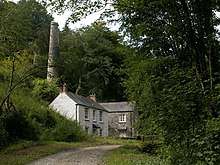
Mining was important in Calstock from Mediaeval times, with the Duchy mining silver. The industry was booming in the late 19th century, and the discovery of copper, coupled with nearby granite quarrying, made Calstock a busy port. The rapid population boom due to the growth of industry led, in 1849, to an outbreak of cholera. The industry declined in the early 20th century due to foreign competition, and now only the ruined pump houses that dot the landscape remain.
Calstock had much mining activity, principally;
- Cotehele Consol - copper and arsenic
- Calstock Consol - copper
- Okeltor Consol - copper, tin and arsenic, mined silver and copper up until 1877
- Wheal Trelawny - copper, very close to Okeltor Consols
- Dansecombe Mines - copper, tin and arsenic
- Wheal Zion - copper
- Wheal Edward - copper and arsenic
- Wheal Arthur - copper and arsenic, directly east of Wheal Edward
Transportation
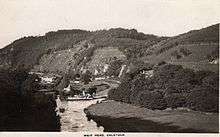
The Tamar is navigable to boats past Calstock some 3 miles (4.8 km) upstream to Morwellham Quay with some 10 feet (3.0 m) or even 20 feet (6.1 m) of water at extreme spring tides. Calstock Quay and Danescombe Quay were once important for transporting minerals from the various mines in the area. In the Victorian era when steamers brought tourists to the village, Calstock was visited by Queen Victoria and Prince Albert in 1846. Tourist boats still operate from Plymouth as far as Cotehele in the summer months. The river has it own unique design of craft, The Tamar barge. The importance of the river as a transport route declined with the construction of the 14 miles (23 km) Tamar Valley railway at the start of the 20th century. The village is still dominated by the railway's viaduct.
Boat building
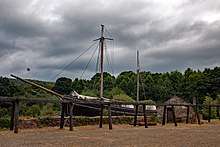
Calstock had two main boat builders, Goss's Yard, which built the ketch Garlandstone, now preserved at Morwellham Quay industrial museum, and May's Yard, in the Danescombe Valley. Garlandstone was, unusually, built as a speculative venture by James Goss to keep his men employed at a period of diminishing repair work following the run down and closure of Morwellham Quay.[12] A surviving Tamar barge, Shamrock, is preserved by the National Trust and National Maritime Museum at Cotehele Quay. A second barge, Lynher, also built by James Goss, is privately owned at Cremyll
Lime production

There are four sets of lime kilns at Calstock and more at Cotehele Quay. Further kilns were located at various points along the river. The burning of lime was a major industry in the area in the 19th century. The limestone was delivered to the kilns by boat but the resulting lime was shipped out to the various farms by horse and cart. It was used as a fertiliser, an ingredient in paint and as a mortar for bricklaying.[13]
Parish church of St Andrew
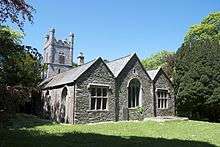
The church is said to have been consecrated about 1290. Nothing obvious remains of this period, but the pillars and arches to the north of the centre aisle of the present building are early 14th century. About 1420 the south aisle was added, and the whole church re-roofed. There were presumably several later restorations, but in 1861 an architectural survey of the diocese of Exeter noted that
the whole church is in a sad state, chocked with pews of all heights . . . encumbered with hideous gallery and collection of rubbish within.
This resulted in the thorough restoration of 1867, carried out at a cost of £600, and under the direction of Mr James Piers St Aubyn (1815–95). St. Aubyn, a relative of the well-known family residents of St Michael’s Mount, had an architectural practise in London and Devonport, and was responsible for the restoration (some would say butchering) of many West Country churches. Here at Calstock the floor levels were altered, the existing tiles laid, the chancel given its present roof, and the buildings furnished with its plain pitched-pine benches. However, severe though the restorations was, many of interesting features of the church were preserved.
Other churches in the parish

St. Annes, Gunnislake
The land was bought on 29 January 1879. The total cost of the building was £2,400 of which the Duke of Bedford gave £500 and the Church building society gave £200. The foundations stone of the church were laid by the Dowager Countess of Mount Edgcumbe, at 3pm on Tuesday, 30 September 1879. The building was designed by Mr J Piers St Aubyn and was consecrated by Edward Benson, the Bishop of Truro in 1880. It was dedicated to St. Anne because of an ancient local Holy Well, close by the site of the church. The Church seats up to 225 worshippers In 1918 Gunnislake appealed to become its own separate parish, but fail to raise the necessary funds.
All Saints, Harrowbarrow
In 1870 a parishioner presented the rector a piece of land, near the Prince of Wales Mine, and then the church was again designed by Mr J. Piers St Aubyn and was built as a school and a mission chapel for £700. The church seats up to 80 worshippers.
Albaston Chapel
The graveyard in front was consecrated in 1888. Outside the chapel, just inside the main gate, there is a large granite memorial cross commemorating 132 men who made the supreme sacrifice in war. The cross bears the following inscription;
Thanks be to God which giveth us the victory. In glorious memory of the men from the parish of Calstock who fell in the Great War 1914–1918. Greater Love hath no man than this that a man lay down his life for his friends.
St Michael and All Angels, Latchely Church
In 1879 the "foundation stone of our long wished for church was laid". Latchely church was designed by Piers St Aubyn, the same architect as Gunnislake. It was built three years later than Gunnislake at a cost of £1,147 as a chapel of Ease dedicated to St Michael and All Angels. It was opened by the Bishop of Truro on 20 July 1883. After a bad attack of wood worm to the chapel in August 1968 the chapel was closed to worshippers and in 1985 it was sold and used for a dwelling.

Cotehele's Chapels
St. Katharine, House Chapel Cotehele
In Cotehele, on the west side of Hall Court is the vicarage and chapel. The chapel, dedicated to St. Katharine and St. Anne, is connected to the main building via a small passageway leading to the dining room. The chapel is one the oldest rooms in the house, alongside the Great Hall. It still has the original clock, a rare example from the Tudor period, still in operation today.
St. Thomas Becket, Woodland Chapel Cotehele
In the grounds of Cotehele, directly East of the House close to the River Tamar, lies a peaceful basic chapel. inside there are pews going around the walls, two minister's benches and a very ornate table. the patron saint of the chapel is St. Thomas Becket.
Primary school
| Calstock Primary School | |
|---|---|
| Address | |
Black Lane Calstock , Cornwall , PL18 9QL | |
| Coordinates | 50.49690°N 4.20397°W |
| Information | |
| Headmaster | Mr Ben Towe |
Calstock Community Primary School was built in 1901 and opened on 6 January 1902. At that time the school consisted of just two main classrooms. It has since been extended with the addition of the infant suite. The infant suite extension won an award for architectural design, in keeping with the remainder of the school. The centenary of the school was celebrated in the summer of 2002.[14] In 2014 Stoke Climsland School federated with Calstock to pool resources. The vast majority of pupils continues their education at Callington Community College or Devonport High School for Boys / Girls.
Railway
East Cornwall Mineral Railway
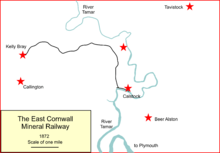
The East Cornwall Mineral Railway was a 1,067 mm (3 ft 6 in) gauge railway line, opened in 1872 to connect mines and quarries in the Callington and Gunnislake areas in east Cornwall with shipping at Calstock on the River Tamar. The line included a rope-worked incline to descend to the quay at Calstock. Wagons with goods from the mines around Gunnislake and Callington were brought down the hillside on a 0.4 miles (0.6 km) cable-worked incline with a gradient of 1 in 6 (17%).
Following the opening of the LSWR mainline railway at nearby Bere Alston, a connecting line from there to Calstock was opened, and the existing line converted to standard gauge, opening throughout as a passenger line in 1908. When rural lines in the area were closed in the 1960s under the Beeching Axe, a short section of the original ECMR line was retained to keep open a connection from Plymouth to Gunnislake, and that section remains open.
Calstock Viaduct
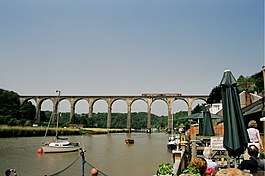
The viaduct is 120 feet (37 m) high with twelve 60 feet (18 m) wide arches, and a further small arch in the Calstock abutment. Three of the piers stand in the River Tamar, which is tidal at this point and has a minimum clearance at high tide of 110 feet (34 m).
It was built between 1904 and 1907 by John Lang of Liskeard using 11,148 concrete blocks. These were cast in a temporary yard on the Devon bank opposite the village. The engineers were Richard Church and W.R. Galbraith. The viaduct was first crossed by truck on 8 August 1907 and first used by passengers on 2 March 1908.
It is a Grade II* listed structure.[15]
Services
Calstock is served by trains on the Tamar Valley Line from Gunnislake to Plymouth. Connections with main line services can be made at Plymouth, although a small number of Tamar Valley services continue to or from Exeter St Davids.[16]
Sports and Leisure
Calstock Football Club
Calstock has a non-league football club, playing in the Duchy League; at the Second Division. Their home ground is on Calstock Quay by the banks of the River Tamar. The clubs’ nickname, The Bees, and logo are derived from Cornwall‘s county colours of black and gold. The club is ran by local volunteers and is sponsored by the Tamar Inn, also located on Calstock Quay.
Literary associations
The poetry publisher Peterloo Poets, founded by Harry Chambers, was based in Calstock from 1976 until it closed down in 2009.[17]
Local Establishments
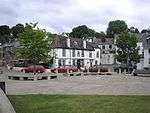
During Victorian times the Parish had "13 churches and 13 taverns." Now the Parish only has four churches and nine taverns, including the Tamar Inn, on Calstock quay, which dates from the 17th century and was rumoured to be the haunt of smugglers and highwaymen,[18] and the Boot Inn, in the centre of the town, built in the year 1666.
Governance
In 1894 the parish was made its own rural district, Calstock Rural District, at the time Calstock had a large population. In 1934 the rural district was abolished and amalgamated with Callington Urban District to form St Germans Rural District. Then in 1974 the St Germans Rural District was amalgamated with Liskeard Rural District to form Caradon. In 2009 Caradon was abolished so that the whole of Cornwall was governed by one unitary authority, Cornwall Council.
Parish Council
Cornwall Council election, 2017
The 2017 Cornwall Council election was held on 4 May 2017 as part of the 2017 local elections in the United Kingdom 122 councilors were elected from the 121 electoral divisions of Cornwall Council.
| Party | Candidate | Votes | % | ± | |
|---|---|---|---|---|---|
| Labour | Dorothy Kirk | 800 | 44.4 | +10.0 | |
| Conservative | Sydney Booth | 660 | 36.7 | +6.6 | |
| Liberal Democrats | Theo Brown | 340 | 18.9 | +7.9 | |
| Majority | 140 | 7.7 | +3.4 | ||
| Turnout | 1,800 | 50.0 | +12.4 | ||
| Labour hold | Swing | ||||
Local Heraldry
For further reading consult; Cornish heraldry
| Coat of Arms of the Calstock Parish Council | |
|---|---|
.png) | |
| Adopted | 2016 |
| Blazon | Sable, Cross Argent, Calstock Viaduct Argent, Two Strawberries Gules, Daffodil Or, Engine House Argent and Picaxe Argent |
| Use | For the Calstock Parish Council |
Twin Towns
Places of interest
| Key | |
| Abbey/Priory/Cathedral | |
| Accessible open space | |
| Amusement/Theme Park | |
| Castle | |
| Country Park | |
| English Heritage | |
| Forestry Commission | |
| Heritage railway | |
| Historic House | |
| Mosques | |
| Museum (free/not free) | |
| National Trust | |
| Theatre | |
| Zoo | |
- Cotehele House


.png)
- Calstock Roman Fort

- Calstock Viaduct
- Tamar Valley Centre

- Calstock Parish Archives

- The Shamrock


See also
References
- Office for National Statistics Archived 8 January 2016 at the Wayback Machine 2011 census - Truro CP
- "List of Place-names agreed by the MAGA Signage Panel" (PDF). Cornish Language Partnership. May 2014. Archived from the original (PDF) on 29 July 2014. Retrieved 11 January 2015.
- Ordnance Survey: Landranger map sheet 201 Plymouth & Launceston ISBN 978-0-319-23146-3
- Office for National Statistics & Cornwall County Council, 2001. Parish population statistics Archived 25 May 2006 at the Wayback Machine
- "2011 census". Retrieved 6 February 2015.
- Calstock Online Parish Clerk, 2005. Calstock Parish Archived 26 November 2005 at the Wayback Machine.
- Cornwall; Explore Britain
- Smart, Chris; et al. "Calstock Roman Fort". Department of Archaeology, the University of Exeter. Retrieved 10 October 2016.
- "Calstock Roman dig reveals 'unexpected' mine". BBC News. Retrieved 6 July 2019.
- Thorn, C. et al., ed. (1979) Cornwall. Chichester: Phillimore; entry 5,2,12
- "The Rise of the Williamses, of Scorrier". The Cornishman (37). 27 March 1879. p. 8.
- Morwellham Quay history and guide. Morwellham Quay. 2017. p. 50.
- Hunt, Rachel (2018). Cotehele. Swindon: National Trust. ISBN 978 1 84359 428 4.
- "Our School". Calstock Community Primary School. Retrieved 23 August 2009.
- "Name: CALSTOCK VIADUCT List entry Number: 1105516". Historic England. Retrieved 19 January 2016.
- Table 139 National Rail timetable, May 2016
- Peterloo Poets. "Harry Chambers". Retrieved 29 March 2015.
- "History". Tama Inn. Retrieved 25 August 2018.
External links
| Wikimedia Commons has media related to Calstock. |
- Calstock Online Parish Clerk
- Calstock History
- Cornwall Record Office Online Catalogue for Calstock
- Calstock Parish Church History, Rev Gordon Ruming